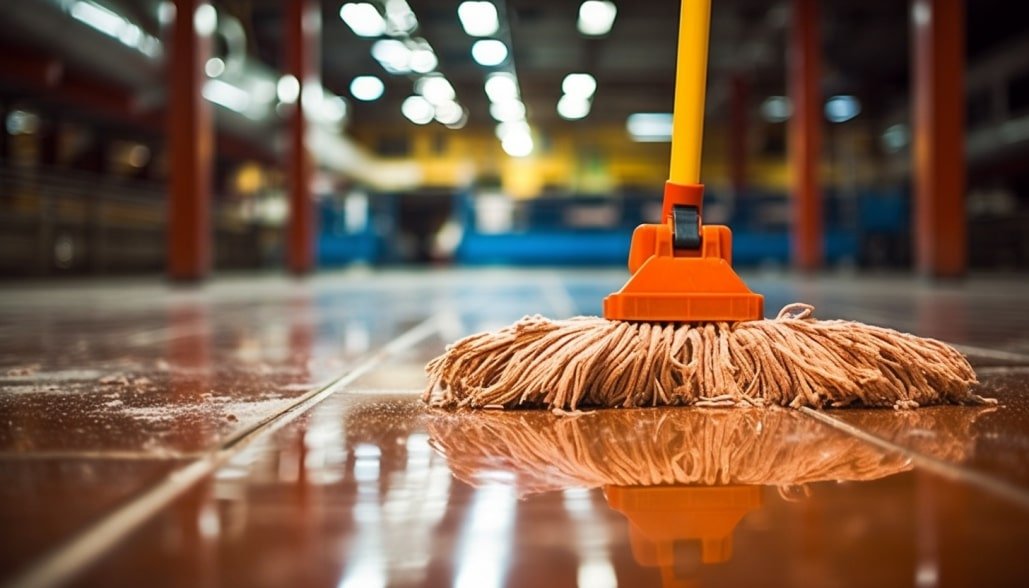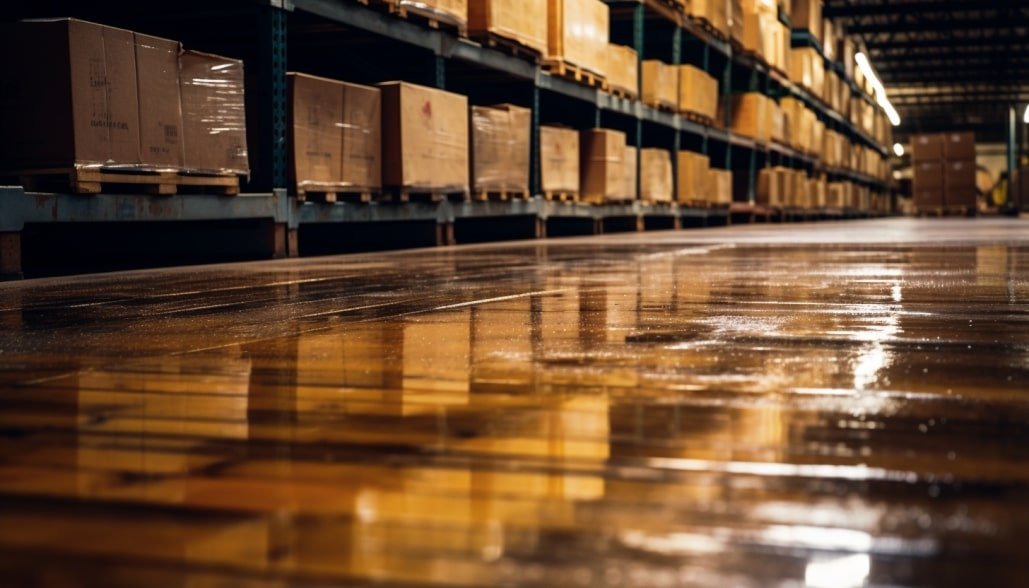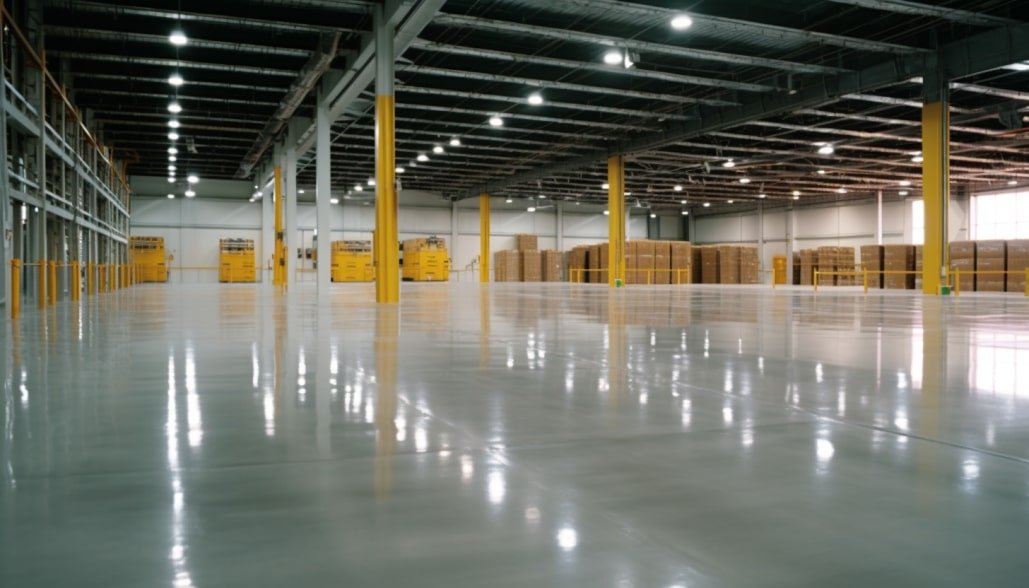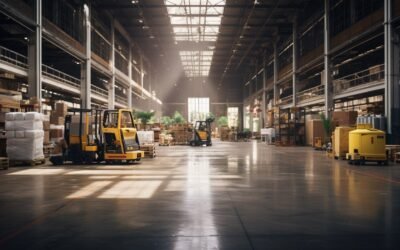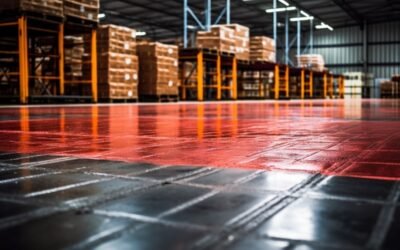The vital role of a clean warehouse in a business’s success cannot be overstated. From ensuring the safety of the workforce to improving productivity and even enhancing the company’s reputation, a well-maintained warehouse serves as the unsung hero of many thriving businesses. However, maintaining a pristine warehouse floor, especially in the challenging Canadian climate, can be a daunting task. The legal landscape, array of cleaning techniques, and the dizzying variety of equipment and solutions can often leave warehouse managers feeling overwhelmed. This comprehensive guide serves to be your beacon, shining a light on the crucial aspects of warehouse floor cleaning, from understanding the basics to mastering advanced techniques. With this guide, warehouse floor cleaning in Canada will no longer be a challenge, but a rewarding task.
Table of Contents
Introduction
Warehouse cleanliness is a topic that extends beyond simple aesthetics. It permeates into aspects of safety, efficiency, and legal compliance, particularly in a country like Canada where health and safety regulations are stringent. Imagine your warehouse floor as the foundation on which your operations are built. If this foundation is shaky – dirty, grimy, cluttered – your operations risk falling into chaos. But fear not, this guide is designed to equip you with the knowledge and techniques needed to maintain a sparkling clean warehouse floor. We’ll delve into the importance of cleanliness, navigate the Canadian legal landscape, and even help you choose the right cleaning equipment and solutions for your specific needs. By the end, you’ll be well-prepared to tackle any warehouse cleaning challenge that comes your way. Buckle up, as we’re about to embark on an enlightening journey into the world of warehouse floor cleaning.
Understanding the Basics of Warehouse Floor Cleaning
Every journey begins with a first step, and ours will start by understanding the very basics of warehouse floor cleaning. While this may seem straightforward, it’s often the basic understanding that can make the difference between a task being executed well or poorly.
Warehouse floors, due to their nature of work, are prone to accumulating a range of dirt and stains. This includes everything from dust and debris brought in by forklifts, to oil spills and chemical stains that can not only tarnish the look of the floor but can also lead to serious accidents. Recognizing the types of dirt and stains commonly found in warehouses is the first step in formulating an effective cleaning strategy.
Now, onto the cleaning techniques. Broadly, these can be divided into manual cleaning and machine cleaning. Manual cleaning involves using mops, brooms, and scrub brushes, and is ideal for smaller spaces or areas that are harder to reach with machines. Machine cleaning, on the other hand, is suited for larger warehouses and involves the use of equipment like floor sweepers and scrubbers. Both methods have their own pros and cons, which we’ll discuss in detail later in this guide.
In terms of cleaning frequency, this can vary depending on factors like the type of goods stored in the warehouse, the volume of traffic, and the specific health and safety regulations in place. On average, however, a good rule of thumb is to sweep warehouse floors daily, and scrub them weekly.
With the basics covered, you’re well on your way to becoming a warehouse cleaning expert. Remember, the key is to adapt the principles to your specific warehouse environment for the best results.
Common Dirt and Stains in Warehouses
Identifying the type of dirt and stains commonly encountered in warehouses is crucial. You’re likely to come across everything from dust and general grime, to oil stains and chemical spills. Each of these require specific cleaning techniques and solutions. For instance, oil stains might need a degreaser, while chemical spills may require absorbent materials and specially formulated cleaners to safely neutralize and remove them.
Dust and debris are often the most common elements found on warehouse floors. Forklifts and other machinery, as well as foot traffic, contribute to this accumulation. A consistent sweeping routine can manage this issue.
Oil and grease stains can be a little more stubborn. Usually a result of machinery leakage or spills during maintenance activities, these stains can pose a serious slipping hazard. You’ll need a degreaser and perhaps a power scrubber for these.
Chemical spills are a different beast altogether. Depending on the nature of the chemical, immediate action and specific cleanup procedures might be required. Always consult Material Safety Data Sheets (MSDS) for guidance on handling such situations.
Understanding these common dirt and stain types equips you to tackle them more effectively, ensuring a cleaner, safer warehouse floor. Remember, the right cleaning strategy can not only make your floors shine but also prolong the life of your warehouse flooring.
Basic Cleaning Techniques
Having discussed the different types of dirt and stains you may encounter, let’s dive into the cleaning techniques to combat them. These techniques largely fall into two categories: manual cleaning and machine cleaning.
Manual cleaning methods include sweeping, mopping, and scrubbing by hand. These methods are cost-effective and can be useful for smaller warehouses or those with less frequent traffic. For instance, a simple mop and bucket could be all you need to clean a small storage area. However, it’s important to ensure that the cleaning solutions used are appropriate for the type of dirt and stains encountered, as well as safe for the floor material.
Machine cleaning involves the use of mechanized equipment like floor sweepers and scrubbers. These machines can clean large areas quickly and efficiently, making them a good choice for larger warehouses with high traffic levels. However, the initial cost of these machines can be high, and they also require regular maintenance.
Determining the frequency of cleaning is another important factor. This depends on the type and volume of traffic, the goods stored, and the specific health and safety regulations applicable. As a general rule, warehouse floors should be swept daily to remove dust and debris, and scrubbed weekly to remove tougher stains and dirt.
With this knowledge in hand, you’re ready to start your journey toward maintaining a sparkling clean warehouse floor. Remember, a clean warehouse is a safe, productive warehouse. So let’s roll up those sleeves and get cleaning!
Manual Cleaning vs. Machine Cleaning
When it comes to warehouse floor cleaning, one of the first decisions you’ll need to make is whether to use manual cleaning methods or invest in machine cleaning. Both have their own benefits and drawbacks, and the right choice depends on your specific circumstances.
Manual cleaning, such as sweeping and mopping, is more labor-intensive but offers a low-cost and straightforward solution for smaller spaces or for warehouses with less traffic. Manual methods allow for greater control over the cleaning process, making it easier to clean corners and other hard-to-reach areas. However, manual cleaning can be time-consuming and less efficient in larger spaces.
Machine cleaning, on the other hand, is a great option for larger warehouses or those with high traffic levels. Equipment like sweepers and scrubbers can clean large areas quickly and efficiently, saving both time and labor costs in the long run. However, these machines come with a higher initial cost and require ongoing maintenance.
Remember, the best cleaning strategy often involves a combination of both manual and machine cleaning. Manual methods can be used for daily maintenance and spot cleaning, while machine cleaning can be scheduled for more thorough weekly or monthly cleanings.
Determining the Frequency of Cleaning
Another key aspect of effective warehouse floor cleaning is determining the right frequency of cleaning. This often depends on the nature of your warehouse operations. For instance, warehouses with high traffic or those storing goods that can easily generate dust or debris may require daily sweeping and more frequent scrubbing.
Health and safety regulations also play a part in determining cleaning frequency. Canadian regulations emphasize maintaining a safe and healthy work environment, which includes keeping floors clean and free of slip or trip hazards. Therefore, any spill or accumulation of dirt should be addressed immediately.
As a general guideline, warehouse floors should be swept daily to remove dust and debris, while scrubbing can be done weekly or bi-weekly to tackle more stubborn stains and grime. However, areas prone to oil or grease spills, such as those near machinery, may require more frequent cleaning. It’s essential to tailor your cleaning schedule to your warehouse’s specific needs to maintain cleanliness and safety.
Remember, maintaining a consistent cleaning schedule not only ensures a clean and safe working environment but also helps to preserve the longevity of your warehouse floor. So, take the time to assess your warehouse’s needs and establish a cleaning routine that best suits your operations.
Navigating Canadian Legal Requirements for Warehouse Cleanliness
Maintaining cleanliness in your warehouse isn’t just about aesthetics or operational efficiency; it’s also a legal requirement. In Canada, there are specific health and safety regulations that employers must follow to ensure a safe working environment, including keeping the warehouse floor clean and free from hazards. This section will guide you through these regulations and provide insights on how to stay compliant.
The Canadian Centre for Occupational Health and Safety (CCOHS) Guidelines
In Canada, the Canadian Centre for Occupational Health and Safety (CCOHS) sets the guidelines for maintaining a safe and healthy work environment. According to the CCOHS, employers are required to take every precaution reasonable in the circumstances to protect the health and safety of workers, and this includes maintaining clean and clutter-free floors.
Floors must be kept clear of obstacles, debris, and spills that could lead to slips, trips, or falls. This is particularly important in a warehouse environment where heavy machinery is often in operation and the risk of accidents is high.
Additionally, the CCOHS recommends implementing a regular cleaning schedule to prevent the accumulation of dust and grime that can cause respiratory issues and other health problems among workers.
Local Municipal Bylaws and Building Codes
Apart from the national guidelines set by the CCOHS, you also need to be aware of any local municipal bylaws or building codes that may apply to your warehouse. These laws can vary from one municipality to another, so it’s important to check with your local authorities.
Some municipalities, for example, may have specific requirements for waste disposal or the use of certain cleaning chemicals. Failure to comply with these regulations can result in fines or other penalties, so it’s crucial to stay informed.
Implementing a Health and Safety Program
To ensure that you stay on top of these legal requirements, it’s a good idea to implement a health and safety program in your warehouse. This program should include procedures for regular floor cleaning and immediate clean-up of spills, training for employees on safety protocols, and regular audits to ensure compliance.
Creating a safety culture within your warehouse not only helps you comply with legal requirements but also fosters a healthier and more productive work environment. It’s a win-win situation for both the employer and the employees.
Remember, maintaining warehouse cleanliness isn’t just about following the law; it’s about ensuring the wellbeing of your workforce. After all, your employees are your most valuable asset, and taking care of them is the best investment you can make.
Choosing the Right Equipment and Solutions for Warehouse Floor Cleaning
Armed with knowledge of the basics and understanding the legal landscape of warehouse floor cleaning in Canada, we’re now ready to delve into the practical side of things – choosing the right cleaning equipment and solutions. Your choice of tools can make a significant difference in the effectiveness of your cleaning efforts, so it’s crucial to invest wisely.
Understanding Different Types of Cleaning Equipment
When it comes to warehouse floor cleaning, there are numerous equipment options available, each with its own strengths and ideal use cases. Manual cleaning tools such as brooms, mops, and scrub brushes are cost-effective and ideal for smaller spaces or detailed cleaning.
However, for larger spaces, mechanized equipment like floor sweepers and scrubbers come into play. Floor sweepers, both ride-on and walk-behind models, are effective at removing dust and loose debris from the floor surface. They work by using rotating brushes to sweep dirt into a built-in hopper for easy disposal.
Floor scrubbers, on the other hand, are designed to handle tougher grime and stains. They use a combination of cleaning solution, scrubbing action, and vacuum suction to deep-clean floors, leaving them dry and spotless. Scrubbers are particularly useful for cleaning oil and grease stains, and can come in both ride-on and walk-behind models.
When choosing cleaning equipment, consider factors like the size of your warehouse, the type of dirt and stains commonly encountered, and the available budget.
Choosing the Right Cleaning Solutions
Alongside the equipment, the cleaning solution you use is also a critical part of the cleaning process. The right cleaning solution can greatly enhance the effectiveness of your cleaning efforts, while the wrong one can be ineffective or even damaging to your floors.
General-purpose cleaners are good for most types of dirt and stains, but for tougher stains like oil or grease, you might need a degreaser. Similarly, for chemical spills, you’ll need a cleaning solution that can safely neutralize the chemical. Always refer to the Material Safety Data Sheet (MSDS) for guidance on handling and cleaning up chemical spills.
Remember, it’s crucial to ensure that the cleaning solutions you use are safe for your floor material. Some harsh chemicals can cause damage to certain types of flooring, so always check the manufacturer’s instructions before use.
Best Practices and Overcoming Challenges in Warehouse Floor Cleaning
Even with the right equipment and cleaning solutions, maintaining a clean warehouse floor can still present challenges. However, by adopting certain best practices and proactive strategies, you can streamline your cleaning process and overcome these hurdles effectively. This section will guide you through some of these key practices and offer solutions to common challenges.
Developing a Cleaning Schedule
Consistency is key when it comes to warehouse floor cleaning. Establish a regular cleaning schedule that aligns with your warehouse’s operational hours and activities. This could mean daily sweeping to remove dust and debris, with more thorough scrubbing done weekly or bi-weekly. Spillages should be handled immediately to prevent accidents and potential damage to the floor. A regular cleaning schedule not only ensures cleanliness but also helps to identify any recurrent issues that need to be addressed.
Training Employees on Safety and Cleanliness Protocols
Proper training is essential in maintaining a clean and safe warehouse. Employees should be educated on the importance of cleanliness and trained on how to clean up minor spills or debris safely and effectively. They should also be familiar with the location of cleaning equipment and supplies, and know how to use them properly. Remember, a well-trained team can significantly contribute to the cleanliness and overall efficiency of your warehouse.
Regular Maintenance of Cleaning Equipment
Just like any other machinery in your warehouse, your cleaning equipment needs regular maintenance to stay in top working condition. Schedule regular check-ups and servicing for your floor sweepers and scrubbers to ensure they’re always ready for use. Also, make sure to clean and store them properly after each use to prolong their lifespan.
Addressing Unique Cleaning Challenges
Each warehouse may have its own unique cleaning challenges based on the type of goods stored, the volume of traffic, and other factors. For example, a warehouse storing automotive parts may have to deal with frequent oil and grease stains, while one storing agricultural products may struggle with dust and organic debris. It’s important to identify these challenges and come up with tailored solutions to address them effectively.
By incorporating these best practices into your cleaning routine, you can make the task of maintaining a clean warehouse floor less daunting and more manageable. Remember, a clean warehouse not only ensures a safe and productive work environment, but it also speaks volumes about your business’s professionalism and commitment to excellence.
A Sparkling Finish: Concluding Thoughts on Warehouse Floor Cleaning
The journey through the labyrinth of warehouse floor cleaning is undoubtedly complex, but with the right knowledge and tools, it becomes a navigable path towards a safer, healthier, and more productive warehouse. From understanding the importance of cleanliness, complying with Canadian legal requirements, selecting the right cleaning equipment and solutions, to implementing best practices, you are now well-equipped to tackle this crucial aspect of warehouse management.
While it’s easy to view floor cleaning as a tiresome chore, remember that it’s a significant part of your warehouse’s overall success. A clean warehouse floor is not only legally compliant but also creates a safer and healthier work environment. It can boost productivity, extend the lifespan of your floor and equipment, and reflect positively on your business reputation. So, roll up those sleeves and let’s make your warehouse sparkle!
Your Cleaning Journey Awaits: FAQs
Is it necessary to clean warehouse floors daily?
The frequency of cleaning depends on the warehouse’s specific needs, such as the nature of operations and the volume of traffic. However, a daily sweep to remove dust and debris is generally recommended.
What cleaning equipment is best for large warehouses?
For large warehouses, mechanized equipment like ride-on sweepers and scrubbers are more efficient at covering large areas. They also save time and reduce manual labour.
How can I remove oil stains from my warehouse floor?
For stubborn oil stains, using a floor scrubber with a degreasing cleaning solution can be effective. Remember to follow the manufacturer’s instructions for the safe and effective use of the cleaning solution.
Can I use any cleaning solution on my warehouse floor?
Not all cleaning solutions are suitable for all floor types. Some harsh chemicals can damage certain floor materials. Always check the manufacturer’s instructions and conduct a patch test before use.
How can I ensure compliance with Canadian legal requirements for warehouse cleanliness?
Regular cleaning, immediate spill clean-up, and maintaining a clean and clutter-free environment are some ways to ensure compliance. Additionally, implementing a health and safety program can help maintain adherence to these guidelines.
Sources
- Legislative Services Branch. “Canada Occupational Health and Safety Regulations.” Justice.gc.ca, 2023, laws-lois.justice.gc.ca/eng/regulations/sor-86-304/index.html. Accessed 15 June 2023.
- Canada,. “WHMIS 1988 – Material Safety Data Sheets (MSDSs): General.” Ccohs.ca, 2015, www.ccohs.ca/oshanswers/legisl/msdss.html. Accessed 15 June 2023.
- Canada,. “Canadian Centre for Occupational Health and Safety.” Ccohs.ca, 2023, www.ccohs.ca/. Accessed 15 June 2023.



